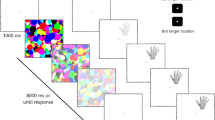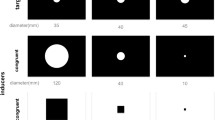Abstract
Visual information regarding limb location can override proprioceptive information when there is conflict between the two—a phenomenon referred to as visual capture. In three experiments, we employed the “mirror illusion,” in which the perceived location of one’s hand is influenced by the visual information specified by the mirror reflection of the other hand, to test whether visual capture influences body-based indications of the extent of objects. Participants viewed their visible hand and its reflection in a mirror after the unseen hand was positioned at one of four locations on a tabletop. The unseen hand’s location appeared to be the same distance from the mirror as the visible hand’s location. After viewing the visible hand and its reflection while simultaneously performing simple finger movements with both hands, participants viewed a block and had to move their unseen hand to a position that would allow them to grasp the block between their two hands. Movements of the unseen hand relative to the visible hand were biased by the visual information, reflecting errors in moved hand position given visual–proprioceptive conflict. In Experiment 1, visual capture influenced the indications of object extent for objects within reach and aligned with the viewer’s midline. Experiments 2 and 3 extended these findings to indications of extent for objects outside the viewer’s reach (Experiment 2) and misaligned with the viewer’s midline (Experiment 3). These results suggest that visual body information has a generalizable effect on actions used to indicate space perception that extends beyond egocentric spatial localization tasks.




Similar content being viewed by others
References
Bailenson JN, Blascovich J (2004) Avatars. In: Bainbridge WS (ed) Encyclopedia of human-computer interaction. Berkshire Publishing Group, Massachusetts, pp 64–68
Berti A, Frassinetti F (2000) When far becomes near: remapping of space by tool use. J Cogn Neurosci 12(3):415–420
Botvinick M, Cohen J (1998) Rubber hands “Feel” Touch that eyes see. Nature 391:756
Colby CL (1998) Action-oriented spatial reference frames in cortex. Neuron 20:15–24
Cutting JE, Vishton PM (1995) Perceiving layout and knowing distances: the integration, relative potency, and contextual use of different information about depth. In: Epstein W, Rogers S (eds) Perception of space and motion. Academic Press, New York, pp 69–117
Hay JC, Pick JHL, Ikeda K (1965) Visual capture produced by prism spectacles. Psychon Sci 2:215–216
Higuchi T, Takada H, Matsuura Y, Imanaka K (2004) Visual estimation of spatial requirements for locomotion in novice wheelchair users. J Exp Psychol Appl 10(1):55–66
Holmes NP, Spence C (2005) Visual bias of unseen hand position with a mirror: spatial and temporal factors. Exp Brain Res 166:489–497
Holmes NP, Spence C (2006) Beyond the body schema: visual, prosthetic, and technological contributions to bodily perception and awareness. In: Knoblich G, Thornton I, Grosjean M, Shiffrar M (eds) Human body perception from the inside out. Oxford University Press, New York
Holmes NP, Crozier G, Spence C (2004) When mirrors lie: visual capture of arm position impairs reaching performance. Cogn Affect Behav Neurosci 4(2):193–200
Iriki A, Tanaka M, Iwamura Y (1996) Coding of modified body schema during tool use by macaque post-central neurons. Neuroreport 7:2325–2330
Ishak S, Adolph KE, Lin GC (2008) Perceiving affordances for fitting through apertures. J Exp Psychol Hum Percept Perform 34:1501–1514
Lenggenhager B, Tadi T, Metzinger T, Blanke O (2007) Video ergo sum: manipulating bodily self-consciousness. Science 317:1096–1099
Longo MR, Lourenco SF (2006) On the nature of near space: effects of tool use and the transition to far space. Neuropsychologia 44:977–981
Longo MR, Lourenco SF (2007) Space perception and body morphology: extent of near space scales with arm length. Exp Brain Res 117:285–290
Maravita A, Iriki A (2004) Tools for the body (schema). Trends Cogn Sci 8(2):79–86
Maravita A, Spence C, Sergent C, Driver J (2002) Seeing your own touched hands in a mirror modulates cross-modal interactions. Psychol Sci 13(4):350–355
Mark LS (1987) Eyeheight-scaled information about affordances: a study of sitting and stair climbing. J Exp Psychol Hum Percept Perform 13:367–384
Mark LS, Balliett JA, Craver KD, Douglas SD, Fox T (1990) What an actor must do in order to perceive the affordance for sitting. Ecol Psychol 2(4):324–366
Mohler BJ, Creem-Regehr SH, Thompson WB, Bulthoff HH (2010) The effect of viewing a self-avatar on distance judgments in an hmd-based virtual environment. Presence: Teleoper Virtual Environ 19(3):230–242
Petkova VI, Ehrsson HH (2008) If i were you: perceptual illusion of body swapping. PLoS One 3(12):e3832
Previc FH (1998) The neuropsychology of 3-d space. Psychol Bull 124:123–164
Ramachandran VS, Rogers-Ramachandran D (1996) Synaesthesia in phantom limbs induced with mirrors. Proc R Soc Lond B Biol Sci 236:377–386
Rizzolatti G, Fadiga L, Fogassi L, Gallese V (1997) The space around us. Science 277:190–191
Short F, Ward R (2009) Virtual limbs and body space: critical features for the distinction between body space and near-body space. J Exp Psychol Hum Percept Perform 35:1092–1103
Slater M, Perez-Marcos D, Ehrsson HH, Sanchez-Vives MV (2008) Towards a digital body: the virtual arm illusion. Front Hum Neurosci 2. doi:10.3389/neuro.09.006.2008
Slater M, Perez-Marcos D, Ehrsson HH, Sanchez-Vives MV (2009) Inducing illusory ownership of a virtual body. Front Hum Neurosci 3(2). doi:10.3389/neuro.01.029.2009
Stefanucci JK, Geuss MN (2009) Big people, little world: the body influences size perception. Perception 38:1782–1795
Wagman JB, Malek EA (2007) Perception of whether an object can be carried through an aperture depends on anticipated speed. Exp Psychol 54:54–61
Wagman JB, Taylor KR (2005) Perceiving affordances for aperture crossing for the person-plus-object system. Ecol Psychol 17:105–130
Warren WH, Whang S (1987) Visual guidance of walking through apertures: body-scaled information for affordances. J Exp Psychol Hum Percept Perform 13:371–383
Witt JK, Proffitt DR, Epstein W (2005) Too use affects perceived distance but only when you intend to use it. J Exp Psychol Hum Percept Perform 31:880–888
Acknowledgments
This work was supported by the National Science Foundation grant number IIS 0914488. Thanks to Istenya Boyle, Kirsten Gregersen, and J. Scott Lauritzen for their help with data collection.
Author information
Authors and Affiliations
Corresponding author
Rights and permissions
About this article
Cite this article
Kunz, B.R., Creem-Regehr, S.H. & Thompson, W.B. Visual capture influences body-based indications of visual extent. Exp Brain Res 207, 259–268 (2010). https://doi.org/10.1007/s00221-010-2445-6
Received:
Accepted:
Published:
Issue Date:
DOI: https://doi.org/10.1007/s00221-010-2445-6




